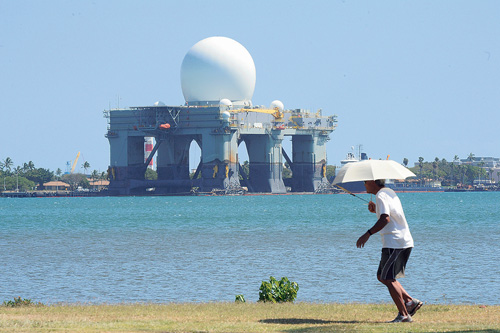Giant ‘golf ball’ radar ship to monitor North Korea

The Sea-Based X-Band Radar
The towering Sea-Based X-band Radar, a fixture at a Ford Island pier for most of the past year, left Pearl Harbor recently for the second time amid heightened concerns over North Korea’s missile program.
Navy Region Hawaii said the 280-foot-tall radar tracking system got under way March 22 “to conduct routine systems checks at sea.”
CNN, however, said the Pentagon made the decision to send the “SBX” and at least one ship to monitor North Korea’s moves.
U.S. officials said a Japan-based U.S. Navy guided-missile destroyer capable of shooting down ballistic missiles had been positioned slightly closer to the Korean peninsula, the Associated Press reported.
The SBX, which has the appearance of a giant golf ball on a six-legged platform, sailed out of Pearl Harbor March 23, 2012, about three weeks ahead of what ended up being a failed April 13 North Korea rocket test.
The Missile Defense Agency, which oversees the SBX as part of the nation’s ballistic missile defense system, could not be reached for comment today.
Don't miss out on what's happening!
Stay in touch with breaking news, as it happens, conveniently in your email inbox. It's FREE!
The phased array radar inside the inflatable dome tracks U.S. and foreign missile tests with 45,000 transmission and receiving elements, and is so powerful it could see a baseball flying through the air 2,500 miles away, according to the agency.
The SBX returned to Pearl Harbor in late May from its last voyage. Asked at the time if the radar ship monitored the launch, Pam Rogers, who was then a Missile Defense Agency spokeswoman, said, “We can’t discuss the nature of the SBX’s operations.”
The one-of-a-kind, $1 billion SBX is a combination of an advanced X-band radar mounted on a mobile, oceangoing, semi-submersible platform.
The Missile Defense Agency said in February of 2012 that it planned to sideline the missile tracker by placing it "in a limited test and contingency operations status" to save $500 million over five years.
The change was detailed as part of the Defense Department’s budget request for 2013, which set out $487 billion in cuts over the next 10 years that are separate from sequester cuts.
It remains unclear where the agency will keep the missile-tracking platform. Pearl Harbor’s Ford Island has become its unofficial home port. Rogers said last year that the SBX would enter “limited test support status” in 2013.



